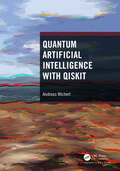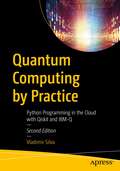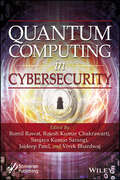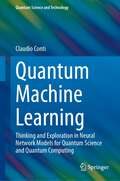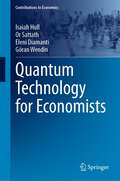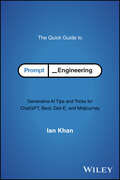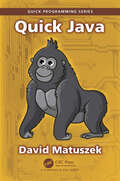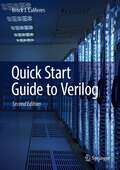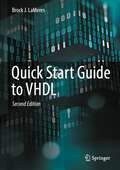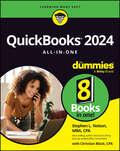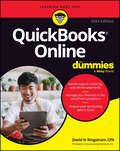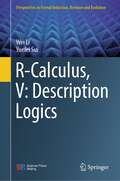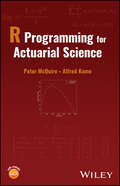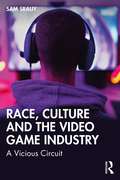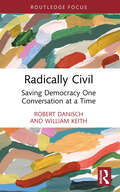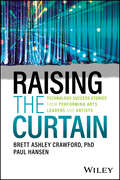- Table View
- List View
Quantum Artificial Intelligence with Qiskit
by Andreas WichertQuantum Artificial Intelligence (QAI) is a new interdisciplinary research field that combines quantum computing with Artificial Intelligence (AI), aiming to use the unique properties of quantum computers to enhance the capabilities of AI systems. This book provides a cohesive overview of the field of QAI, providing the tools for readers to create and manipulate quantum programs on devices as accessible as a laptop computer. Introducing symbolical quantum algorithms, sub symbolical quantum algorithms and quantum Machine Learning (ML) algorithms, this book explains each process step-by-step with associated QISKIT listings. All examples are additionally available for download at https://github.com/andrzejwichert/qai. Allowing readers to learn the basic concepts of quantum computing on their home computer, this book is accessible both the general readership as well as students and instructors of courses relating to computer science and artificial intelligence.
Quantum Artificial Intelligence with Qiskit
by Andreas WichertQuantum Artificial Intelligence (QAI) is a new interdisciplinary research field that combines quantum computing with Artificial Intelligence (AI), aiming to use the unique properties of quantum computers to enhance the capabilities of AI systems. This book provides a cohesive overview of the field of QAI, providing the tools for readers to create and manipulate quantum programs on devices as accessible as a laptop computer. Introducing symbolical quantum algorithms, sub symbolical quantum algorithms and quantum Machine Learning (ML) algorithms, this book explains each process step-by-step with associated QISKIT listings. All examples are additionally available for download at https://github.com/andrzejwichert/qai. Allowing readers to learn the basic concepts of quantum computing on their home computer, this book is accessible both the general readership as well as students and instructors of courses relating to computer science and artificial intelligence.
Quantum Computing by Practice: Python Programming in the Cloud with Qiskit and IBM-Q
by Vladimir SilvaLearn to write algorithms and program in the new field of quantum computing. This second edition is updated to equip you with the latest knowledge and tools needed to be a complex problem-solver in this ever-evolving landscape. The book has expanded its coverage of current and future advancements and investments by IT companies in this emerging technology. Most chapters are thoroughly revised to incorporate the latest updates to IBM Quantum's systems and offerings, such as improved algorithms, integrating hardware advancements, software enhancements, bug fixes, and more. You’ll examine quantum computing in the cloud and run experiments there on a real quantum device. Along the way you’ll cover game theory with the Magic Square, an example of quantum pseudo-telepathy. You’ll also learn to write code using QISKit, Python SDK, and other APIs such as QASM and execute it against simulators (local or remote) or a real quantum computer. Then peek inside the inner workings of the Bell states for entanglement, Grover’s algorithm for linear search, Shor’s algorithm for integer factorization, and other algorithms in the fields of optimization, and more. Finally, you’ll learn the current quantum algorithms for entanglement, random number generation, linear search, integer factorization, and others. By the end of this book, you’ll understand how quantum computing provides massive parallelism and significant computational speedups over classical computersWhat You'll LearnWrite algorithms that provide superior performance over their classical counterpartsCreate a quantum number generator: the quintessential coin flip with a quantum twistExamine the quantum algorithms in use today for random number generation, linear search, and moreDiscover quantum teleportationHandle the counterfeit coin problem, a classic puzzle Put your knowledge to the test with more than 150 practice exercises Who This Book Is ForDevelopers, programmers, computer science researchers, teachers, and students.
Quantum Computing in Cybersecurity
by Romil Rawat Rajesh Kumar Chakrawarti Sanjaya Kumar Sarangi Jaideep Patel Vivek Bhardwaj Anjali Rawat Hitesh RawatMachine learning, deep learning, probabilistic neural networks, blockchain, and other new technologies all demand extremely high processing speeds. A quantum computer is an example of such a system. Quantum computers may be accessed over the internet. This technology poses a significant risk, since quantum terrorists, or cyber criminals, coul be able to cause many problems, including bringing down the internet. The principles of quantum mechanics might be used by evil doers to destroy quantum information on a global scale, and an entire class of suspicious codes could destroy data or eavesdrop on communication. Quantum physics, however, safeguards against data eavesdropping. A significant amount of money is being invested in developing and testing a quantum version of the internet that will eliminate eavesdropping and make communication nearly impenetrable to cyber-attacks. The simultaneous activation of quantum terrorists (organized crime) can lead to significant danger by attackers introducing quantum information into the network, breaking the global quantum state, and preventing the system from returning to its starting state. Without signs of identifying information and real-time communication data, such vulnerabilities are very hard to discover. Terrorists' synchronized and coordinated acts have an impact on security by sparking a cyber assault in a fraction of a second. The encryption is used by cyber-criminal groups with the genuine, nefarious, and terrible motives of killing innocent people or stealing money. In the hands of criminals and codes, cryptography is a dangerous and formidable weapon. Small amounts of digital information are hidden in a code string that translates into an image on the screen, making it impossible for the human eye to identify a coded picture from its uncoded equivalents. To steal the cryptographic key necessary to read people's credit card data or banking information, cyber thieves employ installed encryption techniques, human mistakes, keyboard loggers, and computer malware. This new volume delves into the latest cutting-edge trends and the most up-to-date processes and applications for quantum computing to bolster cybersecurity. Whether for the veteran computer engineer working in the field, other computer scientists and professionals, or for the student, this is a one-stop-shop for quantum computing in cyber security and a must have for any library.
Quantum Computing in Cybersecurity
by Romil Rawat Rajesh Kumar Chakrawarti Sanjaya Kumar Sarangi Jaideep Patel Vivek Bhardwaj Anjali Rawat Hitesh RawatMachine learning, deep learning, probabilistic neural networks, blockchain, and other new technologies all demand extremely high processing speeds. A quantum computer is an example of such a system. Quantum computers may be accessed over the internet. This technology poses a significant risk, since quantum terrorists, or cyber criminals, coul be able to cause many problems, including bringing down the internet. The principles of quantum mechanics might be used by evil doers to destroy quantum information on a global scale, and an entire class of suspicious codes could destroy data or eavesdrop on communication. Quantum physics, however, safeguards against data eavesdropping. A significant amount of money is being invested in developing and testing a quantum version of the internet that will eliminate eavesdropping and make communication nearly impenetrable to cyber-attacks. The simultaneous activation of quantum terrorists (organized crime) can lead to significant danger by attackers introducing quantum information into the network, breaking the global quantum state, and preventing the system from returning to its starting state. Without signs of identifying information and real-time communication data, such vulnerabilities are very hard to discover. Terrorists' synchronized and coordinated acts have an impact on security by sparking a cyber assault in a fraction of a second. The encryption is used by cyber-criminal groups with the genuine, nefarious, and terrible motives of killing innocent people or stealing money. In the hands of criminals and codes, cryptography is a dangerous and formidable weapon. Small amounts of digital information are hidden in a code string that translates into an image on the screen, making it impossible for the human eye to identify a coded picture from its uncoded equivalents. To steal the cryptographic key necessary to read people's credit card data or banking information, cyber thieves employ installed encryption techniques, human mistakes, keyboard loggers, and computer malware. This new volume delves into the latest cutting-edge trends and the most up-to-date processes and applications for quantum computing to bolster cybersecurity. Whether for the veteran computer engineer working in the field, other computer scientists and professionals, or for the student, this is a one-stop-shop for quantum computing in cyber security and a must have for any library.
Quantum Machine Learning: Thinking and Exploration in Neural Network Models for Quantum Science and Quantum Computing (Quantum Science and Technology)
by Claudio ContiThis book presents a new way of thinking about quantum mechanics and machine learning by merging the two. Quantum mechanics and machine learning may seem theoretically disparate, but their link becomes clear through the density matrix operator which can be readily approximated by neural network models, permitting a formulation of quantum physics in which physical observables can be computed via neural networks. As well as demonstrating the natural affinity of quantum physics and machine learning, this viewpoint opens rich possibilities in terms of computation, efficient hardware, and scalability. One can also obtain trainable models to optimize applications and fine-tune theories, such as approximation of the ground state in many body systems, and boosting quantum circuits’ performance. The book begins with the introduction of programming tools and basic concepts of machine learning, with necessary background material from quantum mechanics and quantum information also provided. This enables the basic building blocks, neural network models for vacuum states, to be introduced. The highlights that follow include: non-classical state representations, with squeezers and beam splitters used to implement the primary layers for quantum computing; boson sampling with neural network models; an overview of available quantum computing platforms, their models, and their programming; and neural network models as a variational ansatz for many-body Hamiltonian ground states with applications to Ising machines and solitons. The book emphasizes coding, with many open source examples in Python and TensorFlow, while MATLAB and Mathematica routines clarify and validate proofs. This book is essential reading for graduate students and researchers who want to develop both the requisite physics and coding knowledge to understand the rich interplay of quantum mechanics and machine learning.
Quantum Technology for Economists (Contributions to Economics)
by Isaiah Hull Or Sattath Eleni Diamanti Göran WendinThis book offers an introduction to quantum technology that is specifically tailored to economists, students of economics, and professionals in the financial and payments industries. The book reviews quantum speedups that have been identified for algorithms used to solve and estimate economic models, including function approximation, linear systems analysis, graphical modeling, Monte Carlo simulation, matrix inversion, principal component analysis, linear regression, dynamic programming, interpolation, numerical differentiation, and true random number generation. It also provides an overview of quantum financial technology and its potential applications in economics and finance. Written by an interdisciplinary team with backgrounds in economics, computer science, and physics, this book offers a valuable guide for researchers and practitioners who want to understand the implications and possibilities of quantum technology for the field of economics.
The Quick Guide to Prompt Engineering: Generative AI Tips and Tricks for ChatGPT, Bard, Dall-E, and Midjourney
by Ian KhanDesign and use generative AI prompts that get helpful and practical results In The Quick Guide to Prompt Engineering, renowned technology futurist, management consultant, and AI thought leader Ian Khan delivers a practical and insightful discussion on taking the first steps in understanding and learning how to use generative AI. In this concise and quick start guide, you will learn how to design and use prompts to get the most out of Large Language Model generative AI applications like ChatGPT, DALL-E, Google’s Bard, and more. In the book, you’ll explore how to understand generative artificial intelligence and how to engineer prompts in a wide variety of industry use cases. You’ll also find thoughtful and illuminating case studies and hands-on exercises, as well as step-by-step guides, to get you up to speed on prompt engineering in no time at all. The book has been written for the non-technical user to take the first steps in the world of generative AI. Along with a helpful glossary of common terms, lists of useful additional reading and resources, and other resources, you’ll get: Explanations of the basics of generative artificial intelligence that help you to learn what’s going on under the hood of ChatGPT and other LLMs Stepwise guides to creating effective, efficient, and ethical prompts that help you get the most utility possible from these exciting new tools Strategies for generating text, images, video, voice, music, and other audio from various publicly available artificial intelligence tools Perfect for anyone with an interest in one of the newest and most practical technological advancements recently released to the public, The Quick Guide to Prompt Engineering is a must-read for tech enthusiasts, marketers, content creators, technical professionals, data experts, and anyone else expected to understand and use generative AI at work or at home. No previous experience is required.
The Quick Guide to Prompt Engineering: Generative AI Tips and Tricks for ChatGPT, Bard, Dall-E, and Midjourney
by Ian KhanDesign and use generative AI prompts that get helpful and practical results In The Quick Guide to Prompt Engineering, renowned technology futurist, management consultant, and AI thought leader Ian Khan delivers a practical and insightful discussion on taking the first steps in understanding and learning how to use generative AI. In this concise and quick start guide, you will learn how to design and use prompts to get the most out of Large Language Model generative AI applications like ChatGPT, DALL-E, Google’s Bard, and more. In the book, you’ll explore how to understand generative artificial intelligence and how to engineer prompts in a wide variety of industry use cases. You’ll also find thoughtful and illuminating case studies and hands-on exercises, as well as step-by-step guides, to get you up to speed on prompt engineering in no time at all. The book has been written for the non-technical user to take the first steps in the world of generative AI. Along with a helpful glossary of common terms, lists of useful additional reading and resources, and other resources, you’ll get: Explanations of the basics of generative artificial intelligence that help you to learn what’s going on under the hood of ChatGPT and other LLMs Stepwise guides to creating effective, efficient, and ethical prompts that help you get the most utility possible from these exciting new tools Strategies for generating text, images, video, voice, music, and other audio from various publicly available artificial intelligence tools Perfect for anyone with an interest in one of the newest and most practical technological advancements recently released to the public, The Quick Guide to Prompt Engineering is a must-read for tech enthusiasts, marketers, content creators, technical professionals, data experts, and anyone else expected to understand and use generative AI at work or at home. No previous experience is required.
Quick Java (Quick Programming)
by David Matuszek"We’ll be doing this next project in Java." Unfortunately, you’re a C++ programmer, or maybe a Python programmer. How are you going to get up to speed in a hurry? There are lots of Java books for beginners, telling you all about what a computer is and how it represents everything in bits. You don’t need that. At the other extreme, there are thousand-page tomes that you aren’t going to get through in a few days, if ever. You need something in-between. This book is intended to fill that gap. It’s written for the programmer who doesn’t need to be taught how to program, just how to do it in Java—and who needs to get started in a hurry. Java is covered from the inside out. First, all the things that go inside a class, most of which are practically identical to C++. After that, all the various and complicated kinds of classes and interfaces and how they relate to each other in large-scale programs. Testing is essential, so (unlike most Java books) JUnit is covered in detail. Then, in case you need to go in that direction, some functional programming, a little about parallel programming, and more than enough to get you started in building GUIs (graphical user interfaces) and doing animation. There’s a lot in this little book and, despite my best efforts, you won’t learn Java in a weekend. But it should be a good start. FEATURES Circular approach allows very fast entry into Java Full description of JUnit testing Summary of functional programming in Java Introduction to synchronization and parallel processing Extensive description of building GUIs
Quick Java (Quick Programming)
by David Matuszek"We’ll be doing this next project in Java." Unfortunately, you’re a C++ programmer, or maybe a Python programmer. How are you going to get up to speed in a hurry? There are lots of Java books for beginners, telling you all about what a computer is and how it represents everything in bits. You don’t need that. At the other extreme, there are thousand-page tomes that you aren’t going to get through in a few days, if ever. You need something in-between. This book is intended to fill that gap. It’s written for the programmer who doesn’t need to be taught how to program, just how to do it in Java—and who needs to get started in a hurry. Java is covered from the inside out. First, all the things that go inside a class, most of which are practically identical to C++. After that, all the various and complicated kinds of classes and interfaces and how they relate to each other in large-scale programs. Testing is essential, so (unlike most Java books) JUnit is covered in detail. Then, in case you need to go in that direction, some functional programming, a little about parallel programming, and more than enough to get you started in building GUIs (graphical user interfaces) and doing animation. There’s a lot in this little book and, despite my best efforts, you won’t learn Java in a weekend. But it should be a good start. FEATURES Circular approach allows very fast entry into Java Full description of JUnit testing Summary of functional programming in Java Introduction to synchronization and parallel processing Extensive description of building GUIs
Quick Start Guide to Verilog
by Brock J. LaMeresThis textbook provides a starter’s guide to Verilog, to be used in conjunction with a one-semester course in Digital Systems Design, or on its own for readers who only need an introduction to the language. This book is designed to match the way the material is actually taught in the classroom. Topics are presented in a manner which builds foundational knowledge before moving onto advanced topics. The author has designed the presentation with learning goals and assessment at its core. Each section addresses a specific learning outcome that the student should be able to “do” after its completion. The concept checks and exercise problems provide a rich set of assessment tools to measure student performance on each outcome.Written the way the material is taught, enabling a bottom-up approach to learning which culminates with a high-level of learning, with a solid foundation;Emphasizes examples from which students can learn: contains a solved example for nearly every section in the book;Includes more than 200 exercise problems, as well as concept check questions for each section, tied directly to specific learning outcomes.
Quick Start Guide to VHDL
by Brock J. LaMeresThis textbook provides a starter’s guide to VHDL. This book can be used in conjunction with a one-semester course in Digital Systems Design or on its own for designers who only need an introduction to the language. This book is designed to provide a bottoms-up approach to learning the VHDL language. This design supports a course in which foundational knowledge is covered before moving into advanced topics. However, this design also supports use as a reference manual. The author has designed the presentation with learning goals and assessment at its core. Each section addresses a specific learning outcome that the student should be able to “do” after its completion. The concept checks and exercise problems provide a rich set of assessment tools to measure student performance on each outcome.
QuickBooks 2024 All-in-One For Dummies
by Stephen L. NelsonThe quick way to get started—and get proficient—with QuickBooks QuickBooks 2024 All-in-One For Dummies is the solution small business owners and managers are seeking. This high-value reference combines 8 content-rich mini-books into one complete package, providing the answers you need to get the most out of the 2024 version of QuickBooks. You’ll learn the key features of QuickBooks and small business accounting, including setting up the software, understanding double-entry bookkeeping, invoicing customers, paying vendors, tracking inventory, creating reports, and beyond. Plus, you’ll discover how you can use cloud storage to access your information on your smartphone, making running a small business that much more manageable. Sign up for QuickBooks software, set up your accounts, and customize your preferences Learn the basics of accounting and bookkeeping, and make sure you’re doing it right Discover advanced features of QuickBooks that will help you run your business smoothly and efficiently Save money by confidently managing your finances yourself This beginner-friendly Dummies guide makes it a breeze for small business owners, managers, and employees to implement QuickBooks at work.
QuickBooks 2024 All-in-One For Dummies
by Stephen L. NelsonThe quick way to get started—and get proficient—with QuickBooks QuickBooks 2024 All-in-One For Dummies is the solution small business owners and managers are seeking. This high-value reference combines 8 content-rich mini-books into one complete package, providing the answers you need to get the most out of the 2024 version of QuickBooks. You’ll learn the key features of QuickBooks and small business accounting, including setting up the software, understanding double-entry bookkeeping, invoicing customers, paying vendors, tracking inventory, creating reports, and beyond. Plus, you’ll discover how you can use cloud storage to access your information on your smartphone, making running a small business that much more manageable. Sign up for QuickBooks software, set up your accounts, and customize your preferences Learn the basics of accounting and bookkeeping, and make sure you’re doing it right Discover advanced features of QuickBooks that will help you run your business smoothly and efficiently Save money by confidently managing your finances yourself This beginner-friendly Dummies guide makes it a breeze for small business owners, managers, and employees to implement QuickBooks at work.
QuickBooks Online For Dummies
by David H. RingstromLearn the world’s most popular cloud accounting platform QuickBooks Online For Dummies, 2024 Edition, helps you benefit from fast and easy mobile accounting. This beginner-friendly guide covers the key features of QuickBooks Online, including selecting the subscription version that’s right for you and your business -- Simple Start, Plus, or Advanced. From there, you’ll find everything you need to get started creating invoices and credit memos, recording and paying bills, setting up inventory items, processing payroll and preparing payroll tax returns, balancing accounts, and beyond. You’ll discover how to access your accounts from any device, anywhere—and how to keep your data safe and backed up. For a world on the go, QuickBooks Online makes it easy to keep solid books and be prepared at tax time. With the clear how-tos in this book, you’ll be up and running in no time. Get started with QuickBooks Online and set up your accounts Manage customers, inventory, purchases, payroll, and billing—from anywhere Generate financial reports and simplify your taxes Discover new features and tips in the latest version of the cloud softwareFor small business owners, managers, and employees responsible for business accounting, QuickBooks Online For Dummies helps you make the most of the go-to platform for fluid accounting access.
QuickBooks Online For Dummies
by David H. RingstromLearn the world’s most popular cloud accounting platform QuickBooks Online For Dummies, 2024 Edition, helps you benefit from fast and easy mobile accounting. This beginner-friendly guide covers the key features of QuickBooks Online, including selecting the subscription version that’s right for you and your business -- Simple Start, Plus, or Advanced. From there, you’ll find everything you need to get started creating invoices and credit memos, recording and paying bills, setting up inventory items, processing payroll and preparing payroll tax returns, balancing accounts, and beyond. You’ll discover how to access your accounts from any device, anywhere—and how to keep your data safe and backed up. For a world on the go, QuickBooks Online makes it easy to keep solid books and be prepared at tax time. With the clear how-tos in this book, you’ll be up and running in no time. Get started with QuickBooks Online and set up your accounts Manage customers, inventory, purchases, payroll, and billing—from anywhere Generate financial reports and simplify your taxes Discover new features and tips in the latest version of the cloud softwareFor small business owners, managers, and employees responsible for business accounting, QuickBooks Online For Dummies helps you make the most of the go-to platform for fluid accounting access.
R-Calculus, V: Description Logics (Perspectives in Formal Induction, Revision and Evolution)
by Wei Li Yuefei SuiThis book series consists of two parts, decidable description logics and undecidable description logics. It gives the R-calculi for description logics. This book offers a rich blend of theory and practice. It is suitable for students, researchers and practitioners in the field of logic.
R Programming for Actuarial Science
by Peter McQuire Alfred KumeR Programming for Actuarial Science Professional resource providing an introduction to R coding for actuarial and financial mathematics applications, with real-life examples R Programming for Actuarial Science provides a grounding in R programming applied to the mathematical and statistical methods that are of relevance for actuarial work. In R Programming for Actuarial Science, readers will find: Basic theory for each chapter to complement other actuarial textbooks which provide foundational theory in depth. Topics covered include compound interest, statistical inference, asset-liability matching, time series, loss distributions, contingencies, mortality models, and option pricing plus many more typically covered in university courses. More than 400 coding examples and exercises, most with solutions, to enable students to gain a better understanding of underlying mathematical and statistical principles. An overall basic to intermediate level of coverage in respect of numerous actuarial applications, and real-life examples included with every topic. Providing a highly useful combination of practical discussion and basic theory, R Programming for Actuarial Science is an essential reference for BSc/MSc students in actuarial science, trainee actuaries studying privately, and qualified actuaries with little programming experience, along with undergraduate students studying finance, business, and economics.
R Programming for Actuarial Science
by Peter McQuire Alfred KumeR Programming for Actuarial Science Professional resource providing an introduction to R coding for actuarial and financial mathematics applications, with real-life examples R Programming for Actuarial Science provides a grounding in R programming applied to the mathematical and statistical methods that are of relevance for actuarial work. In R Programming for Actuarial Science, readers will find: Basic theory for each chapter to complement other actuarial textbooks which provide foundational theory in depth. Topics covered include compound interest, statistical inference, asset-liability matching, time series, loss distributions, contingencies, mortality models, and option pricing plus many more typically covered in university courses. More than 400 coding examples and exercises, most with solutions, to enable students to gain a better understanding of underlying mathematical and statistical principles. An overall basic to intermediate level of coverage in respect of numerous actuarial applications, and real-life examples included with every topic. Providing a highly useful combination of practical discussion and basic theory, R Programming for Actuarial Science is an essential reference for BSc/MSc students in actuarial science, trainee actuaries studying privately, and qualified actuaries with little programming experience, along with undergraduate students studying finance, business, and economics.
Race, Culture and the Video Game Industry: A Vicious Circuit
by Sam SrauyA detailed and much needed examination of how systemic racism in the US shaped the culture, market logic, and production practices of video game developers from the 1970s until the 2010s. Offering historical analysis of the video game industries (console, PC, and indie) from a critical, political economic lens, this book specifically examines the history of how such practices created, enabled, and maintained racism through the imagined ‘gamer.’ The book explores how the cultural and economic landscape of the United States developed from the 1970s through the 2000s and explains how racist attitudes are reflected and maintained in the practices of video games production. These practices constitute a 'Vicious Circuit' that normalizes racism and the centrality of an imagined gamer identity. It also explores how the industry, from indie game developers to larger profit-driven companies, responded to changing attitudes in the 2010s, where racism and lack of diversity in games was frequently being noted. The book concludes by offering potential solutions to combat this ‘Vicious Circuit’.A vital contribution to the study of video games that will be welcomed by students and scholars in the fields of media studies, cultural studies, game studies, critical race studies, and beyond.
Race, Culture and the Video Game Industry: A Vicious Circuit
by Sam SrauyA detailed and much needed examination of how systemic racism in the US shaped the culture, market logic, and production practices of video game developers from the 1970s until the 2010s. Offering historical analysis of the video game industries (console, PC, and indie) from a critical, political economic lens, this book specifically examines the history of how such practices created, enabled, and maintained racism through the imagined ‘gamer.’ The book explores how the cultural and economic landscape of the United States developed from the 1970s through the 2000s and explains how racist attitudes are reflected and maintained in the practices of video games production. These practices constitute a 'Vicious Circuit' that normalizes racism and the centrality of an imagined gamer identity. It also explores how the industry, from indie game developers to larger profit-driven companies, responded to changing attitudes in the 2010s, where racism and lack of diversity in games was frequently being noted. The book concludes by offering potential solutions to combat this ‘Vicious Circuit’.A vital contribution to the study of video games that will be welcomed by students and scholars in the fields of media studies, cultural studies, game studies, critical race studies, and beyond.
Radically Civil: Saving Democracy One Conversation at a Time (Routledge Research in Political Communication)
by Robert Danisch William KeithIf you feel like the world has gone to hell in a handbasket, you’re not alone. If you often feel there’s nothing you can do about it, you’re also not alone. Along with this increasing anger, fear, and frustration, much confusion still prevails on the appropriate communication practices for responding to difficult situations and improving our lives. Communication experts, Robert Danisch and William Keith, explain why and how we can practice radical civility in this practical guide to everyday “political” communication. This guide begins with examples of radical civility to show the potential of this kind of communication to change minds and bridge differences. The authors then unpack the three foundational principles of radical civility as useful theoretical tools for thinking throughout interactions with others in civic spaces. This is then followed by a three-step process for practicing radical civility drawing on research into active listening and its importance for creating connections, validating other views, and opening up possibilities for future conversation. The guide concludes with evidence-based communication practices and prescriptive recommendations for how to do each and show examples of each in action. Radically Civil: Saving Democracy One Conversation at a Time is a much-needed communication-based antidote to polarization, preparing students, researchers, and community leaders to be responsible participants in today’s society.
Radically Civil: Saving Democracy One Conversation at a Time (Routledge Research in Political Communication)
by Robert Danisch William KeithIf you feel like the world has gone to hell in a handbasket, you’re not alone. If you often feel there’s nothing you can do about it, you’re also not alone. Along with this increasing anger, fear, and frustration, much confusion still prevails on the appropriate communication practices for responding to difficult situations and improving our lives. Communication experts, Robert Danisch and William Keith, explain why and how we can practice radical civility in this practical guide to everyday “political” communication. This guide begins with examples of radical civility to show the potential of this kind of communication to change minds and bridge differences. The authors then unpack the three foundational principles of radical civility as useful theoretical tools for thinking throughout interactions with others in civic spaces. This is then followed by a three-step process for practicing radical civility drawing on research into active listening and its importance for creating connections, validating other views, and opening up possibilities for future conversation. The guide concludes with evidence-based communication practices and prescriptive recommendations for how to do each and show examples of each in action. Radically Civil: Saving Democracy One Conversation at a Time is a much-needed communication-based antidote to polarization, preparing students, researchers, and community leaders to be responsible participants in today’s society.
Raising the Curtain: Technology Success Stories from Performing Arts Leaders and Artists
by Brett Ashley Crawford Paul HansenLearn how emerging technologies benefit artists and performing arts organizations Raising the Curtain: Technology Success Stories from Performing Arts Leaders and Artists focuses on empowering artists and performing arts organizations in theater, dance, and music to grow audiences and to increase impact through smart and strategic uses of technology. This book will help you effectively increase your artistic and administrative reach in order to expand your outreach to diverse audiences, without breaking the bank. In fact, you’ll be more efficient by choosing multi-function technologies that work for you. You’ll also see how advanced software can extend your donor reach—and ensure that you’re contacting donors at the right time. You can also maximize your organization’s brand by incorporating social media, AI tools, media streaming platforms, and more. Inside, you’ll learn about the most useful tech tools out there, including a wide breadth of technology, from Tessitura to A.I., from the success stories of artists such as Emmet Cohen and Jane Monheit, and organizations such as Attack Theatre and The Kennedy Center. Even more importantly, you’ll gain the confidence you need to incorporate technology into all areas of your organization in order to define your path to greater success. Discover software platforms, online tools, and other interactive technologies useful to designers, artists, and arts organizations Save money, expand your reach, and future-proof your performing arts organization or career Lead conversations about technologies and digital opportunities with staff, board members, or donors Get an overview of technology that addresses the unique opportunities and challenges facing the performing arts industry This book is a great resource for performing arts administrators and artists to learn new ideas about technology solutions. Administrators, leaders, and performers alike will appreciate the opportunity to bring art to audiences using today’s latest innovations.
